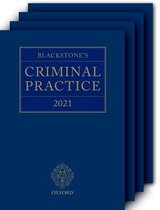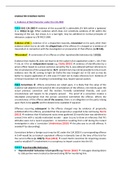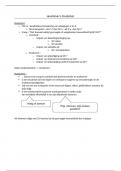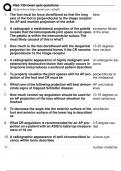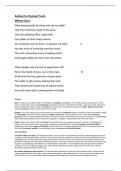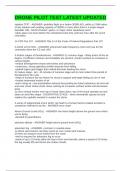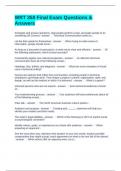1. Evidence of Bad Character under the CJA 2003
F13.4 S101 CJA 2003→ evidence of the accused BC is admissible if it falls within a 'gateway'
in s. 101(a) to (g). Other evidence which does not constitute evidence of BC within the
meaning of the Act, but shows A in a bad light, may be admitted on normal principles of
relevance, subject to s78 PACE 1984.
Evidence of BC = evidence of or a disposition towards, misconduct on his part, other than
evidence which has to do with the alleged facts of the offence D is charged or is evidence of
misconduct in connection with the investigation or prosecution of that offence. (s.98 CJA).
'Misconduct' → commission of an offence or other reprehensible behaviour (s. 112(1)).
Evidence that implies BC does not have to be the subject of an application under s. 101 if the
P rely on it for an independent reason e.g. Clarke [2015] → evidence of identification by a
prison officer based on a prison sentence served by the A, was adduced without reference to
the circumstances of the acquaintance. BUT: problem b/c may not be possible to rely on such
evidence w/o the BC coming to light (in Clarke this was brought out in CE) and so may be
better to require application of s.101 even if P elect not to make reference to it. Evidence of
criminal misconduct not resulting in proceedings may require special caution.
F13.5 Convictions → Where convictions are relied upon, it is likely that the value of the
evidence will depend on the proof of the circumstances of the offence, not merely upon the
actual previous conviction and the matters formally established thereby, and such
circumstances will require to be properly proved. The proof of a conviction creates a
rebuttable presumption that the person convicted committed the offence. Where the
circumstances of the offence are of the essence, there is an obligation on the party relying
upon them to be specific and for details to be available if required.
Offences occurring subsequent to the offence charged may be evidence of propensity
exhibited after the offence, provided that the propensity is expected to be continuing. Norris
[2013] → evidence that N harboured racist views gathered 20 months later was admitted to
connect him with a racially motivated murder - open to jury to draw an inference that N's
attitudes were not a recent acquisition. A conviction resulting from a GP during the instant
investigation is also a ‘conviction’ (Andronicou [2010] → the plea was to an old offence, A
avoided P by absconding).
Convictions before a foreign court may be BC under the CJA 2003 if a corresponding offence
in E+W would be so treated- equivalent offence in domestic law at the time of the trial for
the current offence (s. 103(7)). Plaza [2013] → recent Dutch conviction for importing cocaine
used to establish P's involvement in a conspiracy to import cocaine into the UK.
F13.6-7 Reprehensible Behaviour
• ‘Reprehensible’ behaviour is fact specific e.g. Palmer [2016] → messages showing desire
to stab partner were treated as demonstrating RB for murdering him.
,• 'Reprehensible' connoted an element of culpability or blameworthiness. E.g.
Renda [2005] the fact that the A had been found unfit to plead to an incident that involved
gratuitous violence did not extinguish the element of culpability.
• Conduct is not necessarily 'reprehensible' simply b/c it is morally lax e.g. Manister
[2005] → wrong to regard a sexual relationship by a man in his thirties with a girl of 16 as
'reprehensible'. Fox [2009] → doubted whether the keeping of a notebook containing
'dirty thoughts' be RB.
• Reprehensible is to be distinguished from what is inconvenient to another. Scott [2009]
→ decided under s.100- the complainant of sexual assault was warned by police to cease
her attempts to communicate with a female friend of the accused.
• Being shot is unrealistic to be RB but, as the shooting had the characteristics of a
difference in gangs, might have been preferable to treat it as such (Cambridge [2011]).
• The aggressive/shouting behaviour of a partner towards another over child care did not
constitute RB- would have been preferable to hold the shouting as RB but not relevant to
the charge; murdering a drug dealer (Osborne [2007]).
• Violent rap lyrics by the accused were regarded as RB (Saleem [2007]).
F13.10 a. Misconduct that 'Has to do with' Alleged Facts (excluded from definition and
admissible subject to relevance)
Has to do with = direct relevance. s.98 anticipates a 'nexus' between the evidence of
misconduct and the alleged offending:
a. By temporal connection: evidence of a statement by accused to third party with a threat
to kill the same individual, made 2 days after alleged offence of a threat to kill (McNeil)
b. Other ways of supplying the necessary nexus to the facts:
• Evidence that a killing by S was revenge as part of a gang feud suggested misconduct for
months but was not inadmissible under s. 98- irrational for temporal requirement where
the evidence is reasonably relied upon for motive (Sule [2012]).
• D entitled under s. 98 to rely on his co-accused convictions concerning attempted murders
of other rival gang members in the period leading up to the murder to show his leading
gang position and likelihood of his involvement in the murder (Lunkulu).
• Evidence relating to D’s (solicitor) use of cocaine, was admitted for doing acts tending to
pervert the course of justice by passing on info about police drugs operations to his
supplier. The misconduct provided a reason for the commission of the alleged offence.
• A gang-related killing was alleged to have been in revenge for an earlier murder, and a
participant’s conviction for carrying a knife at the time of the earlier killing was 'highly
relevant' to the facts of the instant case, applying s. 98 (Okokono [2014]).
The commission of a different offence that occurs at or about the time of the offence
charged may also fall within this e.g. conviction for stealing V’s handbag as part of the same
incident admissible under s. 98(a) as plainly relevant (Brand [2009]).
F13.12 b. Misconduct in Connection with Investigation or Prosecution (excluded and
admissible subject to relevance) e.g. evidence relating to e.g. telling lies in interview or
attempted intimidation of witnesses. BUT not limited to conduct by the prosecuting
authorities. E.g. Apabhai [2011]→ evidence of co-accused blackmailing A to matters under
investigation adduced not to demonstrate BC, but to show his motive for incriminating A.
, 2. Gateways to admissibility of non-D BC
s100 CJA 2003→ introduction of BC for persons other than accused. BC definition in s.98
applies equally here. Evidence of BC can be admitted only if it satisfies the further conditions
of admissibility in s.100. Evidence of a medical condition said to affect the credibility or
propensity of a W does not constitute evidence of BC and is admissible at CL.
Evidence 'to do with' the Facts of the Offence or in connection with its Investigation or
Prosecution (s.98) is admissible. (such evidence can be admitted without s.100 b/c not BC).
Evidence “to do with” = GP by co-accused in an offence jointly charged with accused ‘has to
do with’ the offence charged and is not evidence of co-accused BC.
Evidence “in connection” = evidence that police obtained unlawfully/unfairly i.e. fabricating
confession or intimidating witnesses. Evidence of misconduct in other investigations would
seem to be admissible only if s. 100 applies.
GATEWAY = S100 CJA 2003
S.100(1)→ Evidence of BC of a non-D is admissible if and only if-
(a) it is important explanatory evidence,
(b) it has substantial probative value in relation to a matter which—
(i) is a matter in issue in the proceedings, and
(ii) is of substantial importance in the context of the case as a whole, or
(c) all parties to the proceedings agree to the evidence being admissible.
Except where all parties agree, leave of the court is always required.
s.100 applies whether or not person appears as a W so covers→ the character of a person
whose statement is admitted under an exception to the hearsay rule and of the deceased in
a trial for his murder.
FEATURES OF THE ADMISSIBILITY TEST (S.100):
1. The test of 'substantial probative value' is not the same as the test for gateway (d) of s.
101 (accused BC) and where the test is simply one of relevance. BUT is the same as the
test in gateway (e) where evidence is tendered by one co-accused against another.
2. If the conditions of s. 100 are met- there is no statutory discretion where the judge can
refuse to admit the evidence.
3. Rulings by the judge for admissibility in the absence of agreement between the parties
require the exercise of judgment, rather than of discretion.
4. Strict reading of Gateways required to ensure fairness and prevent unnecessary issues.
1. Important Explanatory Evidence (s.100(1)(a))
S.100 (2) → for s.1(a), evidence is important explanatory evidence if—
(a) Without it, the court or jury would find it impossible or difficult properly to understand
other evidence in the case and
(b) It’s value for understanding the case as a whole is substantial.

